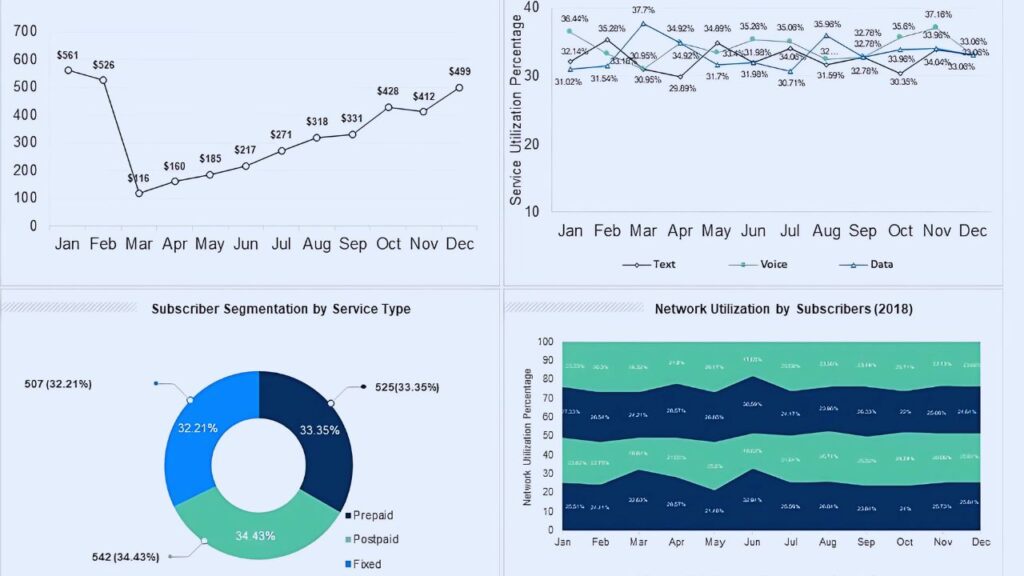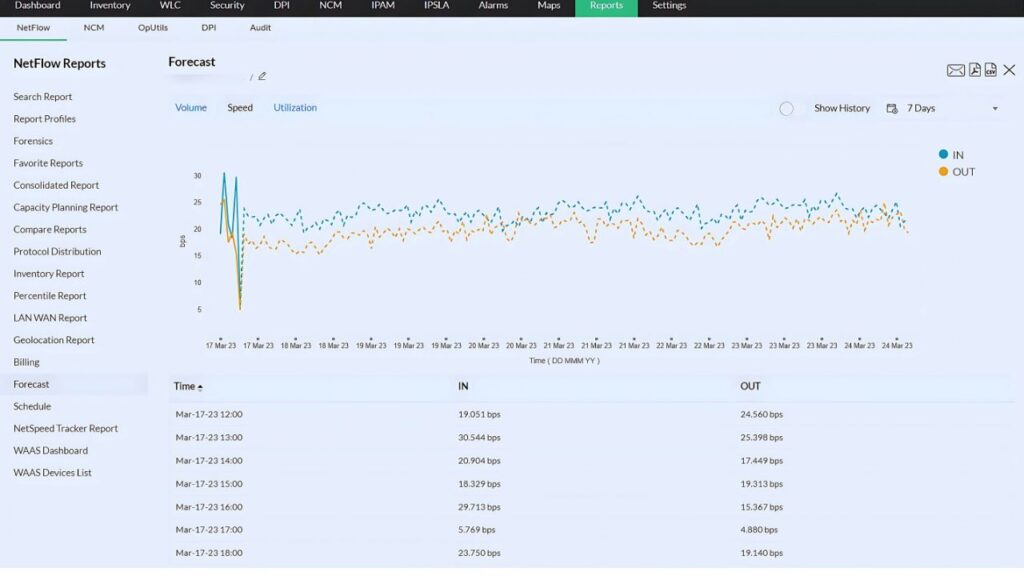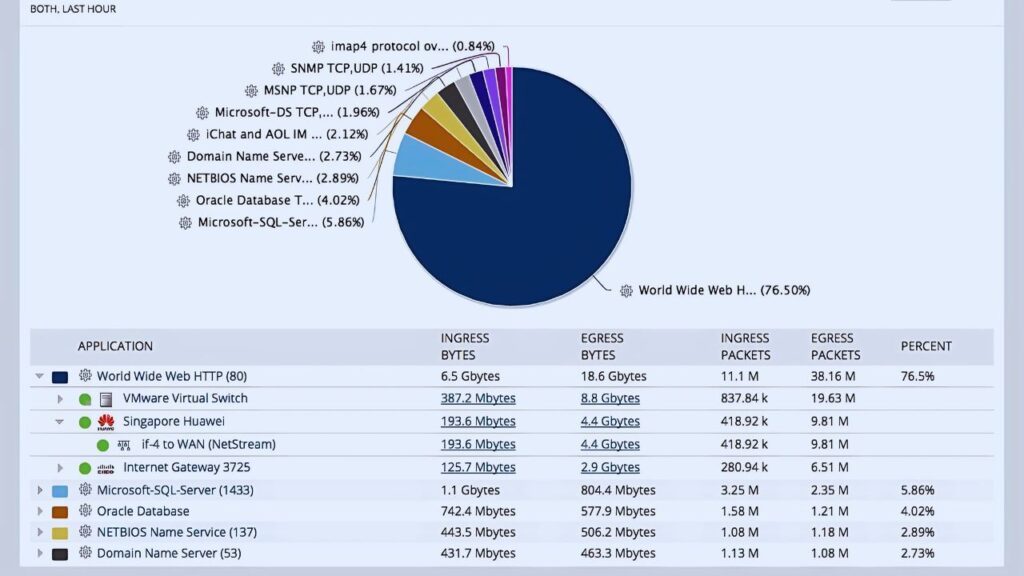Network utilization is a significant indicator of network performance, as it reflects the percentage of available bandwidth being consumed. Monitoring utilization allows you to identify whether the network is under or overutilized, thus influencing the overall user experience and data throughput efficiency.
As organisations rely more on digital infrastructure, understanding and managing network usage becomes essential for optimal operations.
This blog will evaluate the concept of network utilization, explain its relevance, and provide practical guidance on how to monitor and analyze network performance, avoid congestion and increase productivity.
What is Network Utilization?
The current usage level of available network resources is known as network utilization which shows itself through percentages. The metric exists as a percentage value. The data transfer property during a certain time period shows what percentage of available potential network capacity remains in use.
The performance and transmission speed of network systems decreases when network utilization reaches high values but optimal utilization levels help maintain network efficiency. Network utilization requires close attention for efficient operation because poor performance can result from improper management.
What is network utilization rate?

Network utilization rate describes the percentage of a network’s total bandwidth capacity being consumed by actual network traffic throughout a specific time period. This metric is expressed as a percentage, which indicates how much the available network resources are being used.
Network performance evaluation, capacity planning, and network resource utilization assessments all benefit from the network utilization rate, which is an essential measurement tool for determining resource efficiency.
A network with high utilization rates is likely to experience performance degradation, such as crashes and slowdowns, due to overload. Effective network capacity planning and efficient resource usage rely heavily on this rate to optimize network performance, prevent bottlenecks and overloads.
What are the business implications of network utilization?
Network utilization has significant implications for businesses due to the impact it has on operational efficiency and financial performance:
- Network efficiency ensures operational continuity minimizing disruptions to business operations. A functional network supports essential business operations and communication, driving productivity levels.
- Effective resource allocation for your network can reduce unnecessary infrastructure investments. The inefficient allocation of network resources can lead to financial losses, inefficiencies and business disruption.
- System-wide network resource consumption data enables informed decision making, guiding companies to make investments that support future growth and development.
- Business success and operational continuity rely significantly on optimal network utilization, highlighting the importance of robust network planning and management practices.
Best Practices for Optimizing Network Utilization
The following best practices will prepare you to achieve optimal network utilization. The optimal performance of your business network requires you to understand and follow best practices.
These optimization methods will provide you with a guide to implement dependable tools to help optimize network performance.
- Use similar tools for continuous network monitoring to receive instantaneous real-time reporting about network performance together with utilization metrics. The system provides real-time visibility into network performance thus enabling quick resolution of problems to prevent user disruptions.
- Quality of Service (QoS) controls should be deployed to maintain traffic priorities which provide essential applications priority bandwidth over other network activities. The network infrastructure should priorities business critical applications during high utilization.
- Load Balancing solutions should be deployed to distribute network traffic evenly across available resources. This prevents individual devices and routes from becoming overloaded, thereby increasing overall network efficiency.
- To achieve optimal routing performance, network engineers should deploy protocols that direct data along the most efficient network paths. Minimizing unnecessary hops reduces latency and improves network performance.
- Bandwidth resources should be allocated according to application requirements. The network administrator should adjust bandwidth capacity according to the criticality of the information processed by each application.
- Regular updates to network capacity planning ensure you maintain adequate system resources to manage rising demands and traffic peaks. Strategic implementation of network resources helps mitigate shortages and bottlenecks.
- Network devices require sufficient CPU and memory to process traffic loads effectively. Device resources should be updated regularly and upgraded as needed to handle increased demand.
- The network’s design should follow an efficient strategy during its planning and design phase. Design networks to minimize distance data transmission along with reducing excess router jumps.
- Your network should undergo periodic audits to assist in identifying and resolving utilization problems. Review your network performance levels while making changes according to observed results.
- The utilization of cloud services becomes optimized through dynamic resource adjustments that establish better alignment between actual service usage and available resources. Cloud providers offer features of auto-scaling that allow you to take advantage and optimize costs and resource allocation.
- CDNs enable content delivery through local servers that decrease network traffic levels near user locations.
- The implementation of these network monitoring best practices helps organizations optimize their network utilization while enhancing network performance.
What is Network Utilization Monitoring?
Network utilization monitoring is a process of continuously observing and analyzing network traffic and the resources of network devices.
Network utilization monitoring encompasses various metrics such as data transmission rate, bandwidth utilization, and traffic classification. The primary goals of Network utilization are as follows:
- Assess Utilisation of Network Resources: Businesses can evaluate network resource usage, identify congestion points, and determine ways to improve network performance.
- Monitor Network Utilization: This helps identify unauthorized or abnormal fluctuations in traffic that could signal security breaches or cyberattacks. It is essential for maintaining network integrity.
- Network capacity planning: It is imperative to understand historical and real time network utilization data to plan for capacity requirements of the network. It lets organizations put resources where they are needed in order to guarantee that the network will sustain current and future needs.
- Monitor Utilization Patterns: This allows organizations to identify trends, and gather insights that can be leveraged to optimize bandwidth subscriptions, investments in infrastructure, and other cost related network management decisions.
How to monitor network utilization

To avoid slowdowns and ensure reliable performance, network utilization must be kept within appropriate ranges, and network traffic needs to be monitored effectively. This requires focusing on Key Performance Indicators (KPIs),implementing the right tools, and monitoring data closely.
Identify key KPIs
Managing network health relies on focusing on relevant KPIs. The following are important KPIs to be aware of:
Bandwidth usage:
- Measures the volume of data transmitted across a network within a given time period.
- High bandwidth utilization can indicate potential network congestion.
Packet loss:
- This measures the number of data packets that do not arrive at their intended destinations.
- Increasing packet loss rates indicate network issues
Latency:
- Measures the delay in data transmission from one point to another.
- Latency spikes indicate network congestion or aging hardware.
Jitter:
- Measures the variation in delay between received packets.
- High levels of jitter impact real time applications, such as video calls, leading to a degraded user experience.
Techniques for network utilization monitoring:
Real-time traffic analysis
This entails monitoring the flow of network traffic on a continuous basis to quickly detect and identify problems. This is an essential factor in the detection and immediate response to any problem in your network, which can lead to faster resolution times and mitigate degraded performance for users.
Historical data analysis
Analyzing historical network usage data allows you to identify patterns and trends, which helps with capacity planning for future requirements. Understanding the historical context is essential for long term network planning optimization.
Threshold-based alerts
By setting predefined limits on network usage parameters and configuring alerts to trigger when these thresholds are exceeded, the issues can be addressed promptly. Threshold-based alerts are a crucial component to maintain network stability, and without them, overutilization or underutilization would result in revenue loss.
Automated health checks
Regular automated checks are performed on network components to ensure system health and detect any early signs of potential issues. This proactive approach maintains consistent network performance and minimizes downtime. For more visibility, Nile’s Access Service combines both threshold-based alerts and automated AI monitoring.
Predictive analytics
Advanced algorithms use historical data to provide current trend analysis, future prediction statistics of network performance. This assists in identifying performance issues and prevents negative outcomes before they affect performance. Strategic network management and capacity planning heavily involve predictive analytics.
What parts of the network are most affected by poor network utilization?
There are several components of a network that are negatively impacted by high utilization rates.
- Poor network utilization can cause routers and switches to experience operational overload or perform sub-optimally which creates delays and reduces data routing effectiveness.
- Inefficient data transmission utilization results in bandwidth either reaching maximum capacity or underutilization which negatively affects network throughput .
How do you fix high network utilization?

1. Upgrade network infrastructure
The initial step involves the evaluation of your network equipment followed by hardware upgrades where required to increase system capacity. This enables the efficient distribution of higher traffic loads.
2. Implement bandwidth management
Implement Quality of Service which enables critical applications to receive sufficient bandwidth, minimizing disruptions and optimizing application performance.
3. Optimize application performance
Conduct a review to optimize the performance settings of applications that handle large volumes of data. By scheduling large data transfers or updates during off-peak hours and controlling the frequency of these updates, companies can reduce the requirements of network resources during peak times.
Conclusion
Network utilization remains an important factor for maintaining network stability and reliability. Monitoring of these activities provides organizations with the opportunity to solve network-related issues which include high bandwidth utilization and high latency, which assists in optimizing system performance.
Businesses achieve better communication and lower downtime together with improved productivity by using proper network monitoring tools and real-time data to guide usage decisions. Strategies to utilize network resources effectively offer both enhanced business performance and cost reductions because modern businesses depend heavily on digital systems. Thus it represents a fundamental element of robust IT management approaches.


https://shorturl.fm/KqdXw
https://shorturl.fm/HSezJ
https://shorturl.fm/S2UU6
https://shorturl.fm/OTI4r
https://shorturl.fm/vIjve
https://shorturl.fm/L8tIg
https://shorturl.fm/B9UoN
https://shorturl.fm/7km5a
https://shorturl.fm/oBiiE
https://shorturl.fm/Dkcin
https://shorturl.fm/nrEXL
https://shorturl.fm/E1KAA
https://shorturl.fm/1PhYL